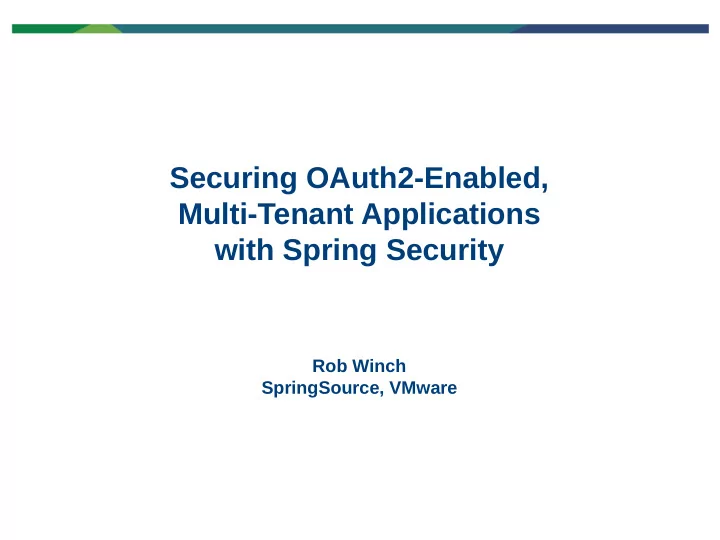

Securing OAuth2-Enabled, Multi-Tenant Applications with Spring Security Rob Winch SpringSource, VMware
About Me ● Spring Security Lead at SpringSource, VMware ● Past ● Cerner: Secure Health Care Applications ● Argonne Labs: Grid Computing ● Loyola University Chicago: Proteomics Research ● Self-Employed: Contractor ● From Kansas City and enjoy playing Softball http://en.wikipedia.org/wiki/File:Kansas_City_MO_Skyline_14July2008v.jpg
Agenda ● Spring Security ● Multi Tenancy ● OAuth 2 ● Links ● Q&A
Tell me about Spring Security ● Formerly known as Acegi Security ● Authentication ● Database, LDAP, CAS, OpenID, Pre-Authentication, custom, etc ● Authorization ● Interface-based proxies, Class-based proxies, AspectJ ● Extensions ● SAML, Kerberos, OAuth ● Simple yet powerful
Basic Spring Security Setup ● Add Spring Security Maven Dependencies ● Update web.xml ● Create Spring Security Configuration
Abstractions ● If you are not implementing a Spring Security interface, it is good practice to abstract usage ● SpringSecurityUserContext accesses our Employee from the SecurityContextHolder ● Customizing the AuthenticationProvider will allow placing your own domain representation in SecurityContext
Defense in Depth ● Securing URLs is not enough. Always secure your service tier too ● Spring Security uses annotations like @PreAuthorize and the <global- method-security> element to protect your services ● Choice of interface-based proxies, class-based proxies, or AspectJ integration
Multi Tenancy – Data ● Multiple Strategies ● Tenant discriminator columns ● Simple to setup, but not as secure and not as flexible (scaling per client not possible) ● Schema or Database per tenant ● Isolation of data and flexibility but more complex to setup ● Multiple implementations ● ORM's (i.e. Hibernate, EclipseLink, etc) ● Spring (AbstractRoutingDataSource)
Multi Tenancy – Resource Mapping ● Domain / Subdomain ● i.e. https://tenantname.example.com/resource/ https://tenantname.com/resource/ ● More complex setup ● More Secure due to same origin policy ● URL ● i.e. https://example.com/tenantname/resource/ ● Simple to setup ● Less secure due to no help from same origin policy
Mutli Tenancy Abstractions ● TenantRoutingDataSource ● TenantFilter ● Obtains and allows access to the current tenant ● Overrides the HttpServletRequest so that the new context root appears to be /context/tenantname/ which means generating links is transparent to us ● TenantContext ● Application uses to obtain the current tenant ● TenantFilter implements this interface ● TenantAware ● For resources/domain objects that are aware of which tenant owns them
Making Resources TenantAware ● We would like to do this without modifying our application code (separation of concerns) ● Create a TenantAwareAspect with AspectJ ● Integrates nicely in Eclipse using AJDT ● m2e provides support for integrating with aspectj- maven-plugin integrates with m2e
Tenant Security ● Do not want tenants to access data from another tenant ● Spring supports custom expressions ● TenantWebExpressionHandler ● Nice abstraction to as how to determine if current user has access
OAuth ● “Valet Key” ● OAuth 2.0 vs OAuth 1.0 ● OAuth 2.0 more simple ● OAuth 2.0 designed for scalability ● Not compatible ● Requires HTTPS ● OAuth 2.0 is not finished
OAuth 2.0 – Basic Flow ● Client asks user for authorization ● Client obtains authorization grant ● Client requests authorization token by authenticating and presenting the authorization grant ● Client requests protected resource using access token
Links ● https://github.com/rwinch/finance/ ● http://springsource.org/spring-security
Q&A Questions?
Recommend
More recommend